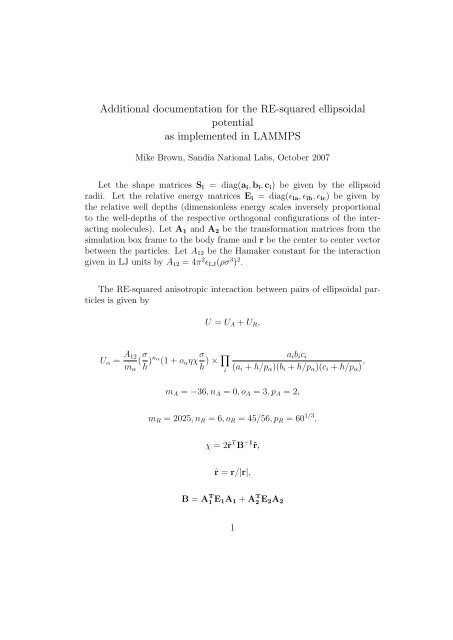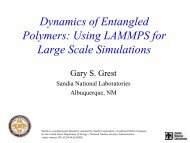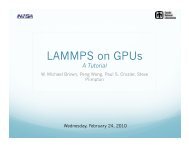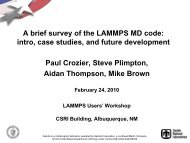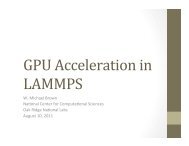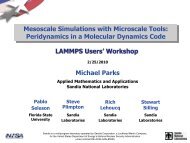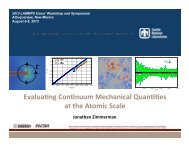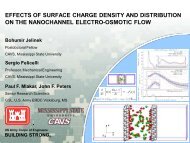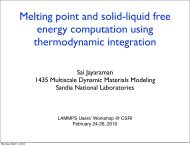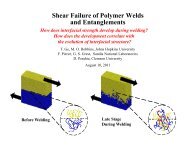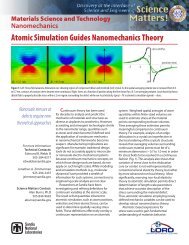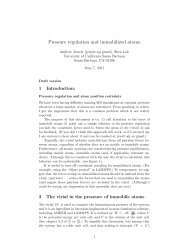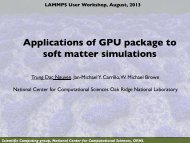Additional documentation for the RE-squared ellipsoidal ... - Lammps
Additional documentation for the RE-squared ellipsoidal ... - Lammps
Additional documentation for the RE-squared ellipsoidal ... - Lammps
You also want an ePaper? Increase the reach of your titles
YUMPU automatically turns print PDFs into web optimized ePapers that Google loves.
<strong>Additional</strong> <strong>documentation</strong> <strong>for</strong> <strong>the</strong> <strong>RE</strong>-<strong>squared</strong> <strong>ellipsoidal</strong><br />
potential<br />
as implemented in LAMMPS<br />
Mike Brown, Sandia National Labs, October 2007<br />
Let <strong>the</strong> shape matrices Si = diag(ai, bi, ci) be given by <strong>the</strong> ellipsoid<br />
radii. Let <strong>the</strong> relative energy matrices Ei = diag(ɛia, ɛib, ɛic) be given by<br />
<strong>the</strong> relative well depths (dimensionless energy scales inversely proportional<br />
to <strong>the</strong> well-depths of <strong>the</strong> respective orthogonal configurations of <strong>the</strong> interacting<br />
molecules). Let A1 and A2 be <strong>the</strong> trans<strong>for</strong>mation matrices from <strong>the</strong><br />
simulation box frame to <strong>the</strong> body frame and r be <strong>the</strong> center to center vector<br />
between <strong>the</strong> particles. Let A12 be <strong>the</strong> Hamaker constant <strong>for</strong> <strong>the</strong> interaction<br />
given in LJ units by A12 = 4π 2 ɛLJ(ρσ 3 ) 2 .<br />
The <strong>RE</strong>-<strong>squared</strong> anisotropic interaction between pairs of <strong>ellipsoidal</strong> particles<br />
is given by<br />
Uα = A12<br />
mα<br />
U = UA + UR,<br />
( σ<br />
h )nα (1 + oαηχ σ <br />
aibici<br />
) ×<br />
h (ai + h/pα)(bi + h/pα)(ci + h/pα) ,<br />
i<br />
mA = −36, nA = 0, oA = 3, pA = 2,<br />
mR = 2025, nR = 6, oR = 45/56, pR = 60 1/3 ,<br />
χ = 2ˆr T B −1 ˆr,<br />
ˆr = r/|r|,<br />
B = A T 1 E1A1 + A T 2 E2A2<br />
1
η = det[S1]/σ 2 1 + det[S2]/σ 2 2<br />
[det[H]/(σ1 + σ2)] 1/2 ,<br />
σi = (ˆr T A T i S −2<br />
i Aiˆr) −1/2 ,<br />
H = 1<br />
A<br />
σ1<br />
T 1 S 2 1A1 + 1<br />
A<br />
σ2<br />
T 2 S 2 2A2<br />
Here, we use <strong>the</strong> distance of closest approach approximation given by <strong>the</strong><br />
Perram reference, namely<br />
and<br />
h = |r| − σ12,<br />
σ12 = [ 1<br />
2 ˆrT G −1 ˆr] −1/2 ,<br />
G = A T 1 S 2 1A1 + A T 2 S 2 2A2<br />
The <strong>RE</strong>-<strong>squared</strong> anisotropic interaction between a <strong>ellipsoidal</strong> particle and<br />
a Lennard-Jones sphere is defined as <strong>the</strong> lima2−>0 U under <strong>the</strong> constraints<br />
that a2 = b2 = c2 and 4<br />
3 πa3 2ρ = 1:<br />
Uαelj = (3σ3 c 3 α<br />
4πh 3 elj<br />
) A12elj<br />
(<br />
mα<br />
σ<br />
helj<br />
Uelj = UAelj + URelj ,<br />
) nα (1+oαχelj<br />
σ<br />
helj<br />
A12elj = 4π2 ɛLJ(ρσ 3 ),<br />
a1b1c1<br />
)×<br />
(a1 + helj/pα)(b1 + helj/pα)(c1 + helj/pα) ,<br />
with helj and χelj calculated as above by replacing B with Belj and G with<br />
Gelj:<br />
Belj = A T 1 E1A1 + I,<br />
2
Gelj = A T 1 S 2 1A1.<br />
The interaction between two LJ spheres is calculated as:<br />
⎡<br />
σ<br />
Ulj = 4ɛ ⎣<br />
|r|<br />
12<br />
−<br />
⎤<br />
6<br />
σ<br />
⎦<br />
|r|<br />
The analytic derivatives are used <strong>for</strong> all <strong>for</strong>ce and torque calculation.<br />
3


